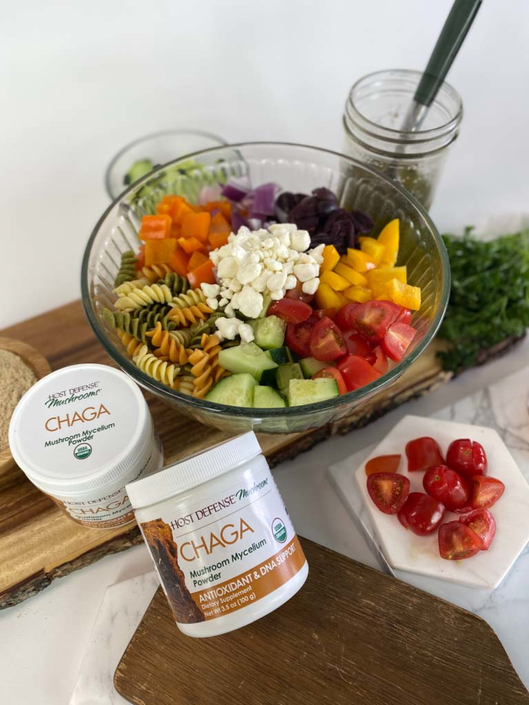Chaga (Inonotus obliquus) is the superhero of mushrooms and an easy-to-use superfood. This nutrient-dense fungus has been harvested by Northern cultures for centuries as a tea, tonic, and topical treatment for indigestion. And now, modern science is tapping into Chaga’s properties to provide antioxidant support against daily free radical damage.*
Chaga’s Roots
This special species of mushroom, found primarily on birch trees in temperate Northern, or boreal, forests, was used in traditional medicine in China, North America, and Europe. Its medicinal uses can be traced back to ancient times for a wide variety of remedies. There is documented use from Hippocrates himself, the father of modern Western medicine.*
The word Chaga comes from the indigenous Khanty culture of reindeer herders in Western Siberia and translates to “mushroom.” As early as the 12th century, the Khanty drank Chaga tea daily to maintain healthy immune and gastrointestinal systems and boost liver and heart health.*
The Health Benefits of Chaga
The revered Chaga mushroom has been studied for its unique compounds and properties, and the list of its scientifically supported health benefits is impressive. Here are some of the evidence-based benefits of this super species*:
- It’s a natural antioxidant. Chaga has been shown to fight the free radicals and oxidative stress associated with DNA damage. Its phenolic compounds and polysaccharides effectively extinguish reactive oxygen species. At least one study has indicated that Chaga may have more antioxidant properties than any other mushroom that’s been under the microscope.*
- It promotes a healthy digestive tract. Research shows that Chaga extracts may help modulate immune response in the intestines, helping to promote healthy cells without causing damage to the sensitive skin of the digestive tract.*
- It supports healthy blood sugar levels already in the normal range. Chaga compounds can help metabolic and pancreatic function, assisting in the regulation of blood glucose and insulin.*
- It’s an immune system regulator. Chaga is considered a biological response modifier, which means it activates a wide array of immune cells, including macrophages, lymphocytes, and NK cells, without going overboard and initiating auto-immune responses or cellular damage.*
What to Look for When Buying Chaga
This mushroom’s superhero status comes from its extraordinary compounds, which are enhanced when the mushroom is cultivated in certain ways. To make sure you are getting full-spectrum formulas with the most potency, look for sustainably grown, fully bio-available fungi supplements with mycelium.*
Mycelia are essentially the building blocks of mushrooms, and mushroom communities. Mycelial cells spread as a network of microscopic fibers in and on top of the soil, and through logs and trees. After a mycelium foundation has been built, the cells focus on creating the structure we call a mushroom.*
Research has shown that Chaga’s mycelium mat contains many, if not all, of the same compounds as its conk (what a mushroom is called when it grows on a tree). Advanced culturing techniques can even enhance medicinal properties by adding minerals and more to the substrates the mushrooms are grown in. For example, research has shown that Chaga mycelium cultured on brown rice produces the highest antioxidant activity of any Inonotus obliquus extracts.*
Some supplement companies cultivate mushrooms using sclerotia, which is akin to mycelium scar tissue. But this indigestible form of these critical cells locks in nutrients, making them less bio-available to you. Make sure to look for Chaga capsules or extracts derived from full, natural Chaga mycelium, and check with the manufacturer to see that cultivation doesn’t impact surrounding species in a negative way.*
*These statements have not been evaluated by the Food and Drug Administration. These products are not intended to diagnose, treat, cure, or prevent any disease.
Supercharge Your Summer Salads
For a creative and savory take on this dynamic superfood, add Chaga powder to your next picnic-ready pasta salad.

CHAGA PASTA SALAD
Time: 20 minutes | 6 Servings
2 tbsp Host Defense® Chaga Powder
12 oz Tri-color Rotini (or favorite pasta)
1 pint Cherry Tomatoes, quartered
1 Bell Pepper, cut into bite-sized pieces
1 Cucumber, cut into bite-sized pieces
1⁄2 Red Onion, diced
1⁄2 cup Kalamata Olives, sliced
4 oz Feta Cheese
For the Dressing:
1⁄2 cup Avocado or Olive Oil
1⁄4 cup Apple Cider Vinegar
1 tbsp Honey
2 tsp Minced Garlic
1 tsp Dried Oregano
Fresh Parsley, chopped
Salt and Pepper to taste
DIRECTIONS
Step 1: Cook pasta as instructed on the box. Wash and cut the vegetables.
Step 2: In a small bowl, prepare the dressing: whisk together ingredients, including Host Defense® Chaga powder, and set aside.
Step 3: In a large bowl, combine cooked pasta, veggies, feta, and dressing. Serve and enjoy!
Host Defense is built on Paul Stamets’ visionary research into the power and potential of mushrooms, especially mushroom mycelium, the root-like structures found growing below ground. The power of Host Defense comes from the discovery that the mycelium is the immune system of the mushroom.